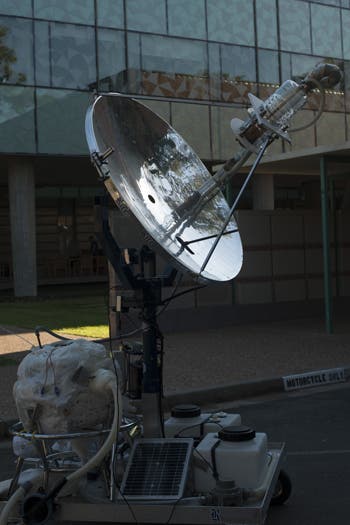
While current solar energy conversion technology is preoccupied with generating electricity with as much efficiency as possible, researchers at Rice University have invented a new technological set-up consisting of nanoparticles smaller than the the wavelength of light that can transform solar energy into steam almost instantly. Their findings show a registered efficiency of 24%, while current solar panel standards range at only 15%.
Since the heydays of the industrial revolution steam has been at the center of energy generation. Even today, 90% of the world’s electricity relies on steam power. Most of this steam is either generated by nuclear power plants or humongous industrial boilers, the Rice invention however is a lot more delicate in nature and has been developed for low-cost sanitation, water purification and human waste treatment for the developing world.
“This is about a lot more than electricity,” said LANP Director Naomi Halas, the lead scientist on the project. “With this technology, we are beginning to think about solar thermal power in a completely different way.”
The technology works by employing light absorbing nanoparticles submerged into water that convert solar energy into heat. Moreover even when submerged into water stacked with ice, Neumann showed she could create steam from nearly frozen water, albeit a lens to concentrate sunlight was used. You can watch the experiment and more details about the project in the video below.
“We’re going from heating water on the macro scale to heating it at the nanoscale,” Halas said. “Our particles are very small — even smaller than a wavelength of light — which means they have an extremely small surface area to dissipate heat. This intense heating allows us to generate steam locally, right at the surface of the particle, and the idea of generating steam locally is really counterintuitive.”
Generating steam directly from solar energy
This is made possible since the nanoparticles after absorbing light instantly reach temperatures well above the boiling point of water, generating steam in the process at temperatures of 150°C (300°F) on the their surface. This is were the catch lies, as well, since the steam can only be generated over a very small surface, locally.
The technology converts about 80 percent of the energy coming from the sun into steam, which means it could generate electricity with an overall efficiency of 24 percent. The Rice researchers believe people in the developing world would be the first to benefit from this kind of technology, as there countless communities around the globe where access to grid electricity is non-existant. The scientists have already demonstrated that their technology can be used for sterilizing medical and dental instruments at clinics that lack electricity.
“Solar steam is remarkable because of its efficiency,” said Neumann, the lead co-author on the paper. “It does not require acres of mirrors or solar panels. In fact, the footprint can be very small. For example, the light window in our demonstration autoclave was just a few square centimeters.”
The findings were detailed in the journal ACS Nano.
source: Rice University


